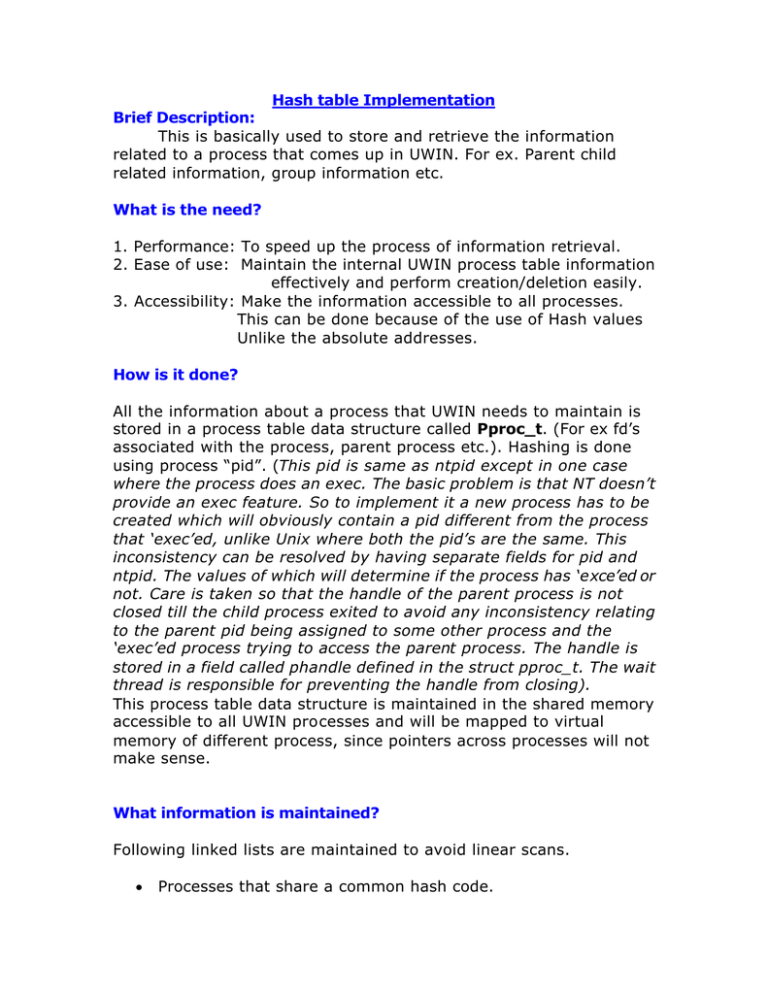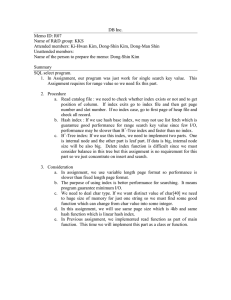Hash table Implementation Brief Description:
advertisement

Hash table Implementation
Brief Description:
This is basically used to store and retrieve the information
related to a process that comes up in UWIN. For ex. Parent child
related information, group information etc.
What is the need?
1. Performance: To speed up the process of information retrieval.
2. Ease of use: Maintain the internal UWIN process table information
effectively and perform creation/deletion easily.
3. Accessibility: Make the information accessible to all processes.
This can be done because of the use of Hash values
Unlike the absolute addresses.
How is it done?
All the information about a process that UWIN needs to maintain is
stored in a process table data structure called Pproc_t. (For ex fd’s
associated with the process, parent process etc.). Hashing is done
using process “pid”. (This pid is same as ntpid except in one case
where the process does an exec. The basic problem is that NT doesn’t
provide an exec feature. So to implement it a new process has to be
created which will obviously contain a pid different from the process
that ‘exec’ed, unlike Unix where both the pid’s are the same. This
inconsistency can be resolved by having separate fields for pid and
ntpid. The values of which will determine if the process has ‘exce’ed or
not. Care is taken so that the handle of the parent process is not
closed till the child process exited to avoid any inconsistency relating
to the parent pid being assigned to some other process and the
‘exec’ed process trying to access the parent process. The handle is
stored in a field called phandle defined in the struct pproc_t. The wait
thread is responsible for preventing the handle from closing).
This process table data structure is maintained in the shared memory
accessible to all UWIN processes and will be mapped to virtual
memory of different process, since pointers across processes will not
make sense.
What information is maintained?
Following linked lists are maintained to avoid linear scans.
•
Processes that share a common hash code.
When 2 or more processes have the same hash code a linked list
containing the processes of the same hash code is maintained.
Thus when there is a clash one has to traverse through this list
to get the process.
•
Process that share a common parent.
This makes the searching of the children easier, especially when
waiting for large number of children to complete.
•
Processes that share a common group.
This makes the searching of processes of same group easier.
Process table entries
Typedef struct Pproc_t
{
…
Short parent; /* Points to parent process */
Short child; /* Points to latest child */
Short group; /* Points to one of the processes in the group */
Short sibling; /* Points to the process that is at the same level as it */
Short next; /* Points to next process in the same hash slot */
…
} Pproc_t;
Taking care of clashes in the hash code
If an entry for process P2 has to be inserted into the slot where, say
entry for P1 is already present, then the entry for P1 is stored in
'P2->next' and the pbq (pointer to the beginning of the queue) for that
slot is filled with entry for P2. This basically is referred to as the slot
value.
next
next
pbq -> P2 -> P1
Similarly, if there is one more clash, the 'list' grows as below:
Next
next
pbq -> P3 ->
P2
next
-> P1
If 'next' is zero, it indicates end of 'list'. Also, if the value in the pbq for
that particular slot is zero, it indicates that there are no processes in
the slot.
Keeping track of Children
If a process P1 generates a child P2 (using a fork or exec), then 'P1>child‘ contains the hash table entry for process P2.
child
P1 -> P2
If again P1 generates a child P3, then 'P1->child' now contains hash
entry for P3 and 'P3->sibling‘ contains hash entry for P2.
child
P1 -> P3
sibling
P2
If 'sibling' is zero, it indicates that the process is at the end of the list.
To walk through all siblings, start at
'Parent->child' and traverse till 'Current->sibling' is zero.
If 'child' is zero, it indicates that the process has no children
Note: Given the hash value the memory location of the process can
always be found.
Tracking processes in the same group
If a process leader P1 and process P2 are of same group, then 'P1>group' contains the hash table entry for process P2.
group
P1 ->
P2
If process P3 joins the group, then 'P1->group' now contains hash
entry for P3 and 'P3->group' contains hash entry for P2.
P1
group
group
->
P3 -> P2
If 'group' of a process is zero, it indicates that the process is at the
end of the list. To walk through all the processes of the same group,
start at the process whose 'pid' is equal to 'pgid' (i.e., process group
leader according to the Unix standards), and traverse till 'Current>group' is zero.
Let us consider a scenario where a process leader dies.
Now the process group leader must not disappear for this to work. If
the process group leader dies, process slot is not freed. Instead, it is
marked as PROCSTATE_EXITED and kept until the last member of the
group terminates. Also, reissuing of this pid must be prevented since
this would create a duplicate pid situation (which is detected and
warned). To do this, the exit code duplicates the process handle to
the init process to keep the handle open when the process group
leader is about to die (this is in DllMain ()). Thus the reference count
to that process is incremented and the process (group leader) is not
freed.
When the last process in the group dies, init process closes this
handle. This message is given to the init process by message posting.
This message is given to the wait thread of init.
Note: This scenario is only for group leader in groups.
Macros and function used
proc_hash()
proc_slot()
given process
proc_findlist()
proc_ptr()
number.
Generates the hash code from the pid supplied
Finds the block number( slot value) into which the
Falls.
Searches the hash slot and returns the process
structure whose pid matches the supplied pid.
Gets the process structure for the supplied block
Code for generating the hash value
(Unsigned short) (pid&(Share->nproc-1))
pid refers to the pid of the process for which the hash value is to be
generated.
nprocs refers to the count of number of processes in UWIN.
Code for getting the slot address given the slot number
(void*)((char*)Pproctab + ((slot)-1)*BLOCK_SIZE)
Pproctab is the pointer, which points to the starting point of the
memory where the array information is stored.
BLOCK_SIZE by default is 512 bytes.
Pproctab[X] will get the process detail of the block whose slot number
is X. This X is calculated by applying the hashing function on the pid.






